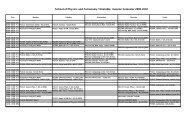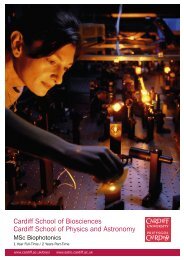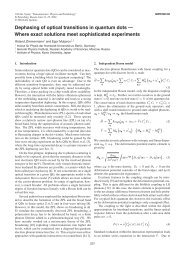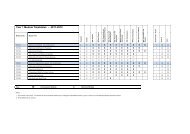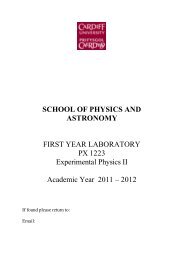PX1121 MECHANICS AND MATTER - Cardiff School of Physics and ...
PX1121 MECHANICS AND MATTER - Cardiff School of Physics and ...
PX1121 MECHANICS AND MATTER - Cardiff School of Physics and ...
You also want an ePaper? Increase the reach of your titles
YUMPU automatically turns print PDFs into web optimized ePapers that Google loves.
PX1124 THE UNIVERSE FROM PARTICLES TO GALAXIES<br />
MODULE INFORMATION:<br />
Autumn semester: 10 credits.<br />
Module organiser: Dr P Hargrave.<br />
Deputy Module Organiser: Dr H L Gomez.<br />
Teaching <strong>and</strong> feedback methods: Lectures 22 x 1 hr, marked exercises.<br />
Assessment: Examination 80%. Coursework 20%. [Examination duration: 2 hours]<br />
Pre-cursors: None.<br />
Co-requisites: None.<br />
Pre-requisites: None.<br />
AIMS OF THE MODULE:<br />
To give an overview <strong>of</strong> the observed structure <strong>of</strong> stars, galaxies <strong>and</strong> the Universe.<br />
To give a simple descriptive account <strong>of</strong> the basic properties <strong>of</strong> matter, including nuclear <strong>and</strong> elementary particles.<br />
To introduce students to the application <strong>of</strong> physical <strong>and</strong> mathematical laws in formulating theories for the origin <strong>and</strong><br />
evolution <strong>of</strong> astronomical structures.<br />
LEARNING OUTCOMES:<br />
The student will be able to:<br />
Describe key developments in the history <strong>of</strong> astronomy.<br />
Explain the principles <strong>and</strong> design <strong>of</strong> astronomical telescopes.<br />
Identify <strong>and</strong> describe the physical properties <strong>of</strong> stars (distances, masses, magnitudes, temperatures).<br />
Describe the elementary structure <strong>of</strong> stars <strong>and</strong> stellar evolution <strong>and</strong> demonstrate basic knowledge <strong>of</strong> binary stars,<br />
supernovae <strong>and</strong> pulsars.<br />
Explain the basic structure <strong>of</strong> galaxies <strong>and</strong> the basic ideas <strong>of</strong> elementary cosmology.<br />
Relate key properties <strong>of</strong> stars <strong>and</strong> galaxies to the fundamental properties <strong>of</strong> matter.<br />
Demonstrate underst<strong>and</strong>ing <strong>of</strong> the physical make up <strong>of</strong> the Universe by answering both essay-style questions <strong>and</strong> solving<br />
unseen numerical problems under examination conditions.<br />
OUTLINE SYLLABUS:<br />
Introduction to Astronomy: Historical background. Ancient astronomy. Scientific astronomy: Copernicus, Tycho Brahe, Kepler,<br />
Galileo <strong>and</strong> Newton, including brief discussion <strong>of</strong> Kepler’s laws (circular orbits only).<br />
Light <strong>and</strong> telescopes: The EM spectrum. Black body radiation. Background radiation. Principles <strong>of</strong> telescope design <strong>and</strong><br />
instrumentation.<br />
The Sun <strong>and</strong> Stars: The magnitude system. Parallax. Inverse square law for flux <strong>and</strong> the distance modulus. The luminosity function<br />
<strong>of</strong> stars. The HR diagram.<br />
Nuclear burning: Nuclear matter (brief history). Energy production in stars. Main-sequence life.<br />
Stellar evolution: The birth <strong>of</strong> stars <strong>and</strong> the inter-stellar medium. The life <strong>and</strong> death <strong>of</strong> stars. Supernovae, Neutron Stars (Pulsars)<br />
<strong>and</strong> Black holes.<br />
Our galaxy: The Milky Way, rotation curves, the local group.<br />
Distances in the Universe: Measuring astronomical distances. Hubble’s law. Cosmological distances. Galaxies.<br />
Cosmology: The creation <strong>and</strong> fate <strong>of</strong> the Universe. Simple models <strong>of</strong> the Universe. Missing mass. Particle physics <strong>and</strong> dark matter.<br />
The twin frontiers <strong>of</strong> physics.<br />
TRANSFERABLE SKILLS:<br />
Problem solving. Investigative skills. Mathematics. Analytical skills.<br />
READING LIST:<br />
Introductory Astronomy <strong>and</strong> Astrophysics, Zeilik <strong>and</strong> Gregory (Saunders College Publishing).<br />
Universe, W Kaufmann (Freeman).<br />
NOTES:<br />
This module can be <strong>of</strong>fered as a FSM. External c<strong>and</strong>idates for this module are advised to have taken A-Level Mathematics.



